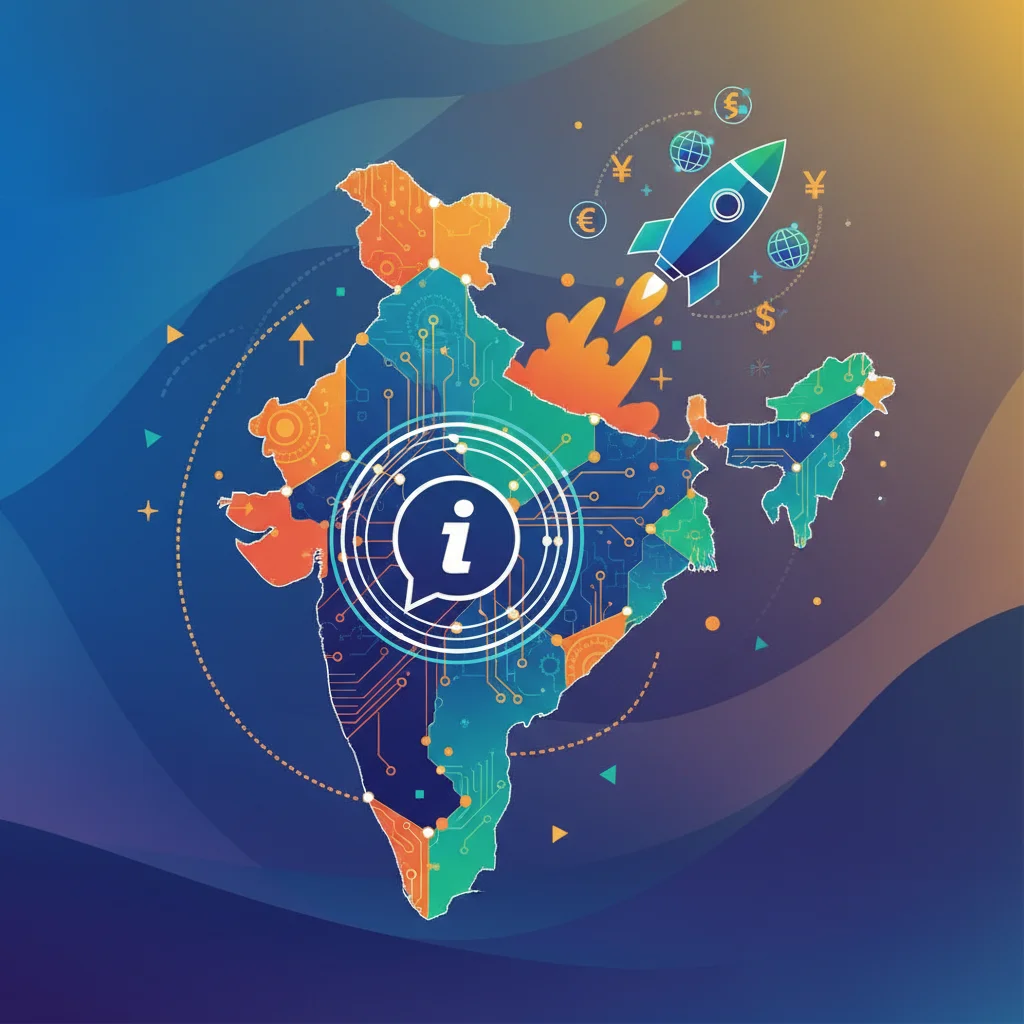
Digital Sovereignty: Why India’s WhatsApp Rival is a Major Signal for Global Investors
In the bustling digital landscape of India, one app reigns supreme: WhatsApp. With over 500 million users, it’s more than a messaging service; it’s a fundamental part of daily communication, commerce, and social interaction. However, a seismic shift is underway, driven by a powerful force that is reshaping global markets: tech nationalism. The Indian government, under Prime Minister Narendra Modi’s “Atmanirbhar Bharat” or “Self-Reliant India” initiative, is actively promoting a homegrown alternative, a move that carries profound implications for the country’s economy, the future of financial technology, and the global investing landscape.
This isn’t merely about creating another app. It’s a strategic declaration of digital sovereignty, a calculated push to build a domestic tech ecosystem that can control its own data, foster local innovation, and reduce dependency on foreign technology giants. For investors, finance professionals, and business leaders, understanding this pivot is crucial. It signals a new chapter in India’s economic story, one where the intersection of technology, policy, and national interest will create both unprecedented opportunities and new, complex risks.
The Genesis of a Digital Challenger: What is ‘Sandes’?
At the heart of this movement is a government-backed messaging platform called ‘Sandes’ (a Hindi word for ‘message’). Initially developed as the Government Instant Messaging System (GIMS) for secure communication within government bodies, its scope has expanded significantly. Top government officials are now openly championing the platform for public use, positioning it as a secure and sovereign alternative to foreign-owned apps like WhatsApp.
This push is part of a broader policy drive. As the Financial Times reports, Prime Minister Modi’s self-reliance campaign gained momentum amidst global trade tensions, including those with the US. The goal is to create Indian champions in critical sectors, and technology is at the top of the list. By encouraging the adoption of Sandes, the government aims to achieve several key objectives:
- Data Localization: Ensuring that Indian user data is stored within the country’s borders, giving authorities greater control and oversight.
- Enhanced Security: Providing a secure communication channel for government and, eventually, citizen-to-government interactions.
- Economic Stimulus: Fostering a domestic app ecosystem, which can lead to job creation, local R&D investment, and the growth of ancillary tech services.
This strategic pivot mirrors a global trend where nations are increasingly viewing the digital sphere through a geopolitical lens. The concept of a single, open internet is fracturing, giving way to a “splinternet” where national interests dictate digital borders.
Pharma's High-Stakes Gamble: Inside the Pfizer vs. Novo Bidding War for a Weight-Loss Unicorn
Tech Nationalism: A Global Phenomenon with Local Implications
India’s strategy is not happening in a vacuum. It’s a prominent example of tech nationalism, a trend where governments prioritize their domestic tech industry and exert greater control over the digital infrastructure within their borders. This approach has profound consequences for international trade, investment, and the global stock market valuations of tech behemoths.
To understand the context, it’s helpful to compare different national strategies for digital sovereignty.
| Region/Country | Core Strategy | Key Example(s) | Primary Motivation |
|---|---|---|---|
| China | State Control & Ecosystem Creation | The “Great Firewall,” WeChat, Alibaba | Information control, economic protectionism, creating national champions. |
| European Union | Regulatory & Rights-Based | GDPR (General Data Protection Regulation), Digital Markets Act | User privacy, data protection, curbing monopoly power of US tech firms. |
| India | Self-Reliance & Platform Building | Atmanirbhar Bharat, UPI, Sandes App | Data security, reducing foreign dependency, fostering a domestic fintech ecosystem. |
| United States | Market-Driven & National Security | Export controls on specific technologies, CFIUS reviews | Promoting private sector leadership while protecting critical technology and infrastructure. |
As the table illustrates, India is carving its own path. Unlike China’s top-down control or the EU’s regulatory focus, India’s approach is centered on building foundational public digital infrastructure—like the Unified Payments Interface (UPI)—and then encouraging a domestic ecosystem to build on top of it. Sandes is the latest, and perhaps most ambitious, piece of this puzzle.
Imagine an app that seamlessly integrates with your digital ID (Aadhaar), your bank accounts via UPI, and your tax filings. This is where the real disruption lies. Looking further ahead, a platform like Sandes could become the distribution channel for a future Central Bank Digital Currency (CBDC), or a Digital Rupee. This could leverage distributed ledger technology, or blockchain, to ensure secure and transparent transactions, fundamentally reshaping India’s financial landscape. The goal isn’t just to capture the messaging market; it’s to build the secure, sovereign backbone for India’s digital economy.
The Investment Thesis: Unpacking the Financial and Economic Impact
For the finance and investment community, this development is a multifaceted signal that warrants close attention. The implications extend far beyond the tech sector, touching everything from consumer banking to macroeconomic policy.
1. A Catalyst for the Domestic Fintech Ecosystem
A government-backed super-app could be an explosive catalyst for India’s already vibrant financial technology sector. By providing a secure, ubiquitous platform, Sandes could lower the barrier to entry for startups building solutions in:
- Digital Payments: Deeper and more streamlined integration with UPI could challenge the dominance of players like Google Pay and PhonePe.
- Micro-lending and Insurance: Using the platform for KYC (Know Your Customer) and distribution could drastically reduce costs for financial service providers.
- Wealth Management: Simplified platforms for mutual fund investing and stock trading could be integrated, bringing financial services to a wider audience.
This creates a fertile ground for venture capital and private equity investors looking to back the next wave of Indian innovation. Companies that align with this “Atmanirbhar” vision may find themselves with a significant competitive advantage.
2. Re-evaluating Risk for Foreign Tech Giants
For international investors holding stock in companies like Meta (formerly Facebook), this signals a growing regulatory risk. India’s push for self-reliance means foreign firms may face stricter data localization laws, higher compliance costs, and direct competition from state-backed entities. The “India growth story” for Big Tech is still strong, but the rules of the game are changing. This new dynamic must be priced into any trading or long-term investment strategy.
Cleared for Chaos: How a Government Shutdown Grounds Flights and Shakes the Global Economy
3. A Litmus Test for the ‘Atmanirbhar Bharat’ Economy
The success or failure of Sandes will be a powerful indicator of the viability of India’s broader self-reliance strategy. If the government can successfully drive adoption, it will validate its approach to building a domestic digital economy. This could boost investor confidence in other “Make in India” sectors, from manufacturing to defense. A successful rollout would signal policy stability and a strong government commitment to its economic vision, a key factor in long-term capital allocation.
The Uphill Battle: Challenges on the Road to Digital Self-Reliance
Despite the strong government backing, the path for Sandes is fraught with challenges. The platform must overcome significant hurdles to achieve mainstream adoption and truly compete with established global players.
Here’s a comparative look at the key challenges Sandes faces against an incumbent like WhatsApp.
| Factor | WhatsApp (Meta) | Sandes (Govt. of India) |
|---|---|---|
| User Base & Network Effect | Massive, entrenched user base (over 500 million in India). Everyone is already on it. | Starting from a low base. Must build a critical mass of users to become useful. |
| User Experience (UX) & Features | Highly polished, feature-rich, and constantly updated by a global tech giant. | Needs to achieve feature parity and offer a seamless, bug-free experience to compete. |
| Trust & Data Privacy | Faces public skepticism over data sharing with parent company Meta. | Must overcome citizen concerns about potential government surveillance and data security. |
| Primary Value Proposition | Universal social communication and peer-to-peer commerce. | Security, data sovereignty, and integration with government digital services. |
The trust factor is a double-edged sword. While some users are wary of WhatsApp’s data policies, an equal or greater number may be hesitant to use a government-controlled app for private conversations. Transparency and a clear, robust privacy policy will be paramount to Sandes’ success.
The End of Free Rides: Why the UK is Gearing Up for Pay-Per-Mile EV Charging
Conclusion: A Bellwether for a New Economic Era
India’s promotion of the Sandes messaging app is far more than a technological curiosity; it is a bellwether for a new era of geopolitical economics. It represents a determined effort by the world’s fifth-largest economy to forge its own digital destiny, control its data, and build a self-reliant technological future.
For the global financial community, this is a pivotal moment. It underscores the need to look beyond traditional financial metrics and incorporate geopolitical and policy analysis into investment decisions. The rise of tech nationalism in India and beyond is creating a new set of winners and losers. The companies and investors who succeed will be those who understand this new landscape, appreciate the drive for digital sovereignty, and can navigate the complex interplay between technology, finance, and the state.


